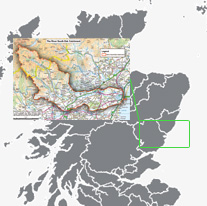Biodiversity
This section deals with habitats and species that are threatened within the catchment and non-native species which arestarting to invade the area. The catchment supports a wide range of habitats and species, from the uplands on the edge ofthe Cairngorms to the tidal wetland area of Montrose Basin with its tens of thousands of wildfowl which stay here overwinter.

A number of these habitats are recognised natural heritage designations (see 1C The Legal framework), which highlights just how important the area is for nature conservation. However, natural heritage designations only protect thebest examples of habitats and species that have been recognised because they are important at an international, European or national level.
There are several habitats of local importance within the area that contribute a lot, as well as providing valuable functions such as helping to contain flood waters and break down pollutants. Riparian woodlands and wet grasslands are examples of habitats that are becoming increasingly broken up across the area. A good example is found at the Den of Ogil SSSI, where the Burn of Ogil joins the Noran water. Here willow and alder woodland contains species suchas marsh marigold and ragged robin growing beneath them and are interspersed with sedge-rich areas.

These areas have reduced in number across the catchment, where floodplains have been drained for development, agriculture and forestry. Land drainage activities also lead to more sediment released into the catchment, leading to effects on spawning gravelsand freshwater pearl mussel beds.
There are a number of invasive non-native species in the area that affect our native species and the habitats that support them. These include invasive weeds such as giant hogweed which take over the riverbank and, when they die back inautumn, leave exposed bare banks that make riverbank erosion worse. Mink threaten water voles, while the North American signal crayfish eat fish eggs and quickly take over the river.
The Esk Rivers and Fisheries Trust have recently produced a ‘bio-security plan’ (2009) which looks at ways of managing these invasive non-native species already in the area and reducing the risk of new invasive non-native species entering the area such as the salmon parasite, Gyrodactylus salaris and the Chinese mitten crab. Both of these could have severe consequences on the economy as well as threatening our native species.
Latest News
 Partnership begins consul...
Partnership begins consul...- This autumn the partnership ho... 29/08/2018 - Read more >>
 Almost a decade of partne...
Almost a decade of partne...- The River South Esk Catchment ... 09/05/2017 - Read more >>
 We know the catchment is ...
We know the catchment is ...- We want you to tell us about y... 09/05/2017 - Read more >>
Geographic Location


